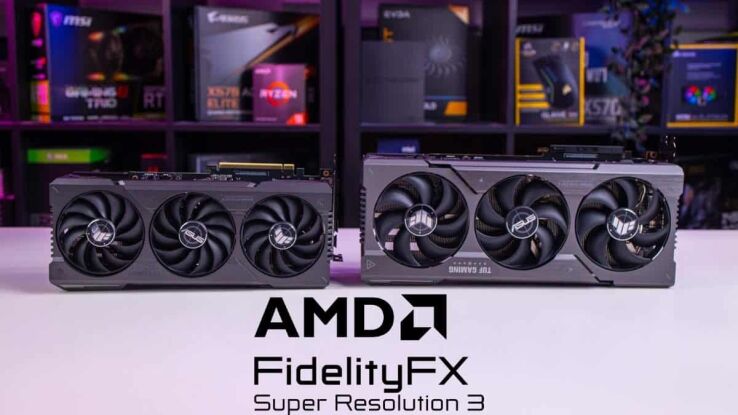AMD FSR 3.0 – everything you need to know
As games get more and more intensive, FSR and upscaling might be the way forward

WePC is reader-supported. When you buy through links on our site, we may earn an affiliate commission. Prices subject to change. Learn more
What might be a saving grace for a lot of gamers, especially those of use with aging hardware, is the implementation of upscaling technologies. As such FSR 3 is the next iteration of AMD’s solution to the problem able to be implemented into games.
Although it was announced with the RTX 7900 XTX GPUs, and likely in response to Nvidia’s DLSS 3 feature, it would offer quite the improvement over previous iterations like its competitor’s option. But it took some time for it to come out, so lets see when it was released and what it has to offer.
Best GPU deals
- Sapphire Pulse AMD Radeon RX 7900 XTX – Save $360 now!
- Sapphire Nitro+ AMD Radeon RX 7900 XTX Vapor-X Gaming Graphics Card – Save $380 now!
- MSI Gaming GeForce RTX 4070 Ti 12GB GDRR6X – Save 7% NOW!
- XFX Speedster SWFT319 Radeon RX 6800 Core Gaming Graphics Card – Save 13% NOW!
- ZOTAC Gaming GeForce RTX 4070 Ti Trinity OC – Save $100 NOW!
- MSI Gaming GeForce RTX 3090 – Save 37% NOW!
- GIGABYTE GeForce RTX 3060 Gaming OC – Save $130 NOW!
- XFX Speedster MERC310 AMD Radeon RX 7900XTX Black Gaming Graphics Card – Save 8% NOW!
- MSI Gaming GeForce RTX 4080 – Save 12% NOW!
- MSI Gaming GeForce RTX 4070 Ti – Save $105 NOW!
When is AMD FSR 3 coming?
AMD finally announced support for FSR 3 in September 2023, with Forspoken and Immortals of Aveum being the games coming in first with the inclusion of the new technology. It does not have full support from all the games yet so will be implemented one by one so it might be some time yet before your game will see it.
What does AMD FSR 3 add?
Looking at the key differences in what FSR is going to be adding, AMD said these may be subject to change as of yet. Since some of these might take a bit more time to implement or are just too much to implement straight away. Especially if it is expected to be released anytime soon to actually be used.
Up to 2x performance over FSR 2
FSR 3 would benefit from what FSR 2 already has. With the current implementation computing more pixels than samples in the current frame, more can be generated from interpolated frames. similar to Nvidia’s frame generation, this can produce the in-between parts and produce a smoother experience with faster performance for the graphics.
So using motion vectors and AMD Fluid Motion is what will produce these new frames. As with good motion, estimation is important for interpolation as that prevents the jittering you could see if it interprets the object in the wrong place and takes you out of the experience. So also clarifying that FSR 2 information can be used as well to improve what 3 can do.
And in the workflow timeline for the technologies, AMD has outlined how it will change (as seen in the above image). Where 3 differs from 2 is the addition of interpolation after upscaling, post-FX, and UI. These also present the frames more often so in that same scale, you get 2x more than 2, which was already doubling how many over native rendering.
Latency reduction
One of the bigger reasons to skip over any upscaling is the effect it has on the responsiveness of the gameplay. This does mean quite a lot of work is required to implement it, but it does mean that it should be a better experience as you don’t have that delay that might cost you something when playing it. So that would mean not having to choose over the framerate or the feel, although AMD anti-lag has also come for improvements.
Easy transition
Another important feature to the developers of the games is the easy transition from one to the other. If a game already has FSR 2 implemented in it, going to 3 should be no harder than adding it in. As such it provides a better offering for the audience of the game and makes life much simpler for the devs.
Permissive license
Another important feature for accessibility is the software coming in under the MIT license. This means it is a permissive free software license allowing anyone to use, copy, modify, and so on for free. Therefore, developers don’t need permission to implement FSR 3 into their games and rather have it as soon as they need, allowing it to be featured in more games with ease.
FAQs
Will there be FSR 3?
Yes AMD has released FSR 3 now and is being rolled out in games.
Will FSR 3 work on Nvidia?
It is very likely that FSR 3 will continue to work on Nvidia’s graphics cards. It mentioned that it wants to continue supporting their cards so more people have access to it. This is also the reason why it is open source and available for any developer to implement, so more gamers can access the tech.